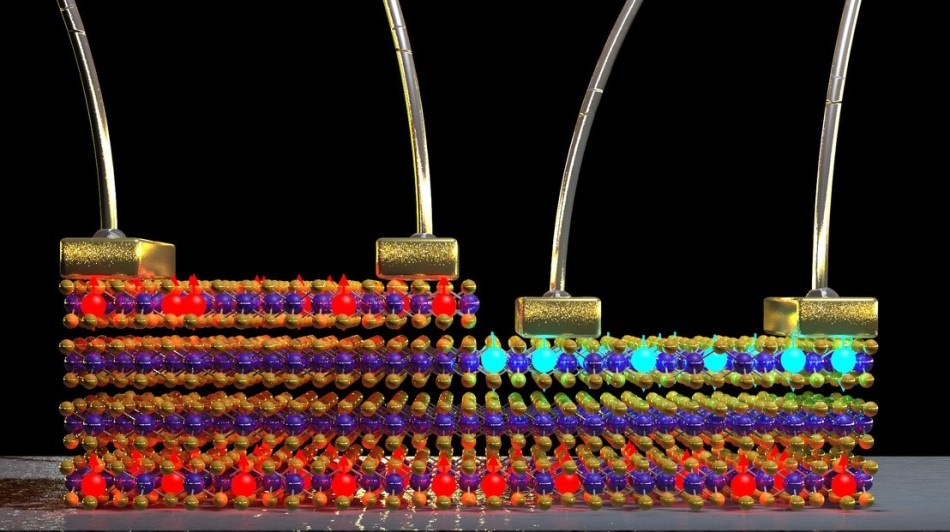Jun 18 2019
All are familiar with the image of electrons that zip around the nucleus of an atom and form chemical bonds in molecules and materials. However, a lesser known fact is that electrons possess an additional exclusive property—spin.
 EPFL scientists have discovered a new type of 2D magnetic material that can be integrated into spintronic devices. (Image credit: A. Avsar/EPFL)
EPFL scientists have discovered a new type of 2D magnetic material that can be integrated into spintronic devices. (Image credit: A. Avsar/EPFL)
Although it is not easy to make an analogy, electron spin can be roughly described as a spinning-top rotating around its axis. However, a more intriguing fact is that when electrons’ spins align together in a material, the result is the famous phenomenon of magnetism.
Spintronics, which is one of the most groundbreaking fields in technology, is a still-experimental attempt to design and develop devices such as memories and computers that operate based on electron spin instead of just the movement of charges (which is the electrical current). However, applications such as these require new magnetic materials that have innovative properties.
For instance, it would be highly beneficial if magnetism exists in a very thin layer of the material—what are called two-dimensional (2D) materials, including graphene that is fundamentally an atom-thick layer of graphite.
However, it is very difficult to find 2D magnetic materials. Chromium iodide (CrI3) was recently found to exhibit many intriguing properties; however, it quickly disintegrates in ambient conditions and its insulating property does not make it potentially useful for spintronics applications, a majority of which necessitate air-stable and metallic magnetic materials.
The teams of Andras Kis and Oleg Yazyev at EPFL have discovered a new metallic and air-stable 2D magnet—platinum diselenide (PtSe2). Ahmet Avsar, a postdoc in Kis’s lab, chanced upon this material while he was, in fact, looking into something completely different.
The researchers explained the discovery of magnetism in PtSe2 by first using calculations based on density functional theory—a technique that involves modeling and analyzing the structure of complex systems with a number of electrons, including nanostructures and materials. The theoretical study revealed that PtSe2’s magnetism is due to what are called the “defects” on its surface—irregularities in the way atoms are arranged.
More than a decade ago, we found a somewhat similar scenario for defects in graphene, but PtSe2 was a total surprise for us.
Oleg Yazyev, EPFL
The scientists validated the existence of magnetism in the material with a robust magneto-resistance measurement method. It was astonishing to observe the magnetism because perfectly crystalline PtSe2 is presumed to be non-magnetic.
This is the first time that defect-induced magnetism in this type of 2D materials is observed. It expands the range of 2D ferromagnets into materials that would otherwise be overlooked by massive database-mining techniques.
Andras Kis, EPFL
It is sufficient to remove or add one PtSe2 layer to alter the way spins interact with each other across layers. Moreover, even more promising about it is the fact that it is possible to further manipulate its magnetism, even within the same layer, by deliberately forming defects across its surface—a process called “defect engineering” that can be achieved by irradiating the surface of the material with proton or electron beams.
Such ultra-thin metallic magnets could be integrated into the next generation spin-transfer torque magnetic random-access memory [STT MRAM] devices. 2D magnets could reduce the critical current required to change magnetic polarity, and help us with further miniaturization. These are the major challenges that companies are hoping to solve.
Ahmet Avsar, Postdoc, EPFL
This study was funded by the European Research Council, Swiss National Science Foundation, Marie Curie-Sklodowska COFUND, and European Union’s Horizon 2020 (Graphene Flagship).